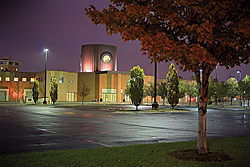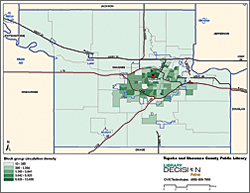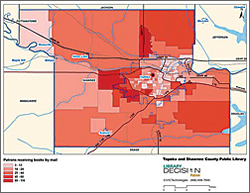ArcUser Online
This article as a PDF . A Kansas library district used Tapestry, an Esri data product, and analysis provided by a GIS consulting firm to learn more about its patrons so it can better identify their needs, develop and manage services delivery, and market its services effectively. Market segmentation is well known in the business community, which has used it successfully for many years for ongoing activities such as business expansion, site selection, competitive analysis, marketing campaigns, and many other common business procedures. However, it is gaining increasing use among public entities, such as libraries that need a greater understanding of users so that they can better serve them. Tapestry Segmentation classifies U.S. neighborhoods into 65 distinctive segments based on their socioeconomic and demographic composition. The analysis also provides lifestyle information including interests and buying habits. When recently faced with preparing a strategic plan called The Next Decade, Gina Millsap, executive director of the Topeka and Shawnee County Public Library (TSCPL) in Topeka, Kansas, decided to conduct an analysis of her community and its library patrons. "We contracted with CIVICTechnologies to work with us by utilizing GIS data analysis to correlate customer, circulation, materials, and programming attendance statistics with demographic and marketing segmentation data," said Millsap. "It was our hope that this approach, in contrast to the traditional user and community surveys, would tell us much more about who is using the library, how they are using it, what they aren't using, what they might be interested in using, and who isn't using library services." Esri business partner CIVICTechnologies develops GIS-based solutions for public agencies and nonprofit organizations. In this case, the goal of the analysis was to identify underserved segments, assess their needs, develop appropriate resources to meet those needs and deliver those services, and implement a marketing campaign targeted at selected segments. This analytic process began with mapping the relationships between patrons and nonpatrons and examining checkouts, material types, and market segments. CIVICTechnologies uses Tapestry Segmentation in developing community profiles. Six primary Tapestry market segments—Green Acres, Rustbelt Traditions, Home Town, Exurbanites, Midlife Junction, and Cozy and Comfortable—accounted for 53 percent of the population served by the library, with the remaining 47 percent fragmented across 24 other segments. Each segment was ranked for its potential to add patrons and increase library checkouts. This information helped TSCPL identify needs, as well as develop and manage its service delivery and marketing programs. Marc Futterman, president and CEO of CIVICTechnologies, noted, "In contrast to TSCPL's top six segments, inner city tenants (a segment typically considered underprivileged) accounts for only 1.1 percent of the population, or 1,916 people. For TSCPL, this segment represents the highest patron penetration rate among all 30 segments—77 percent of inner city tenants are patrons—and the fifth highest average checkouts per patron (1.78 items). In this case, the library is providing exceptional service to a market that is often considered underserved. "Service to juveniles and young adults is also very important to the TSCPL program. We ranked the potential to increase youth patronage and checkouts in each of the 30 segments. The Home Town segment, for example, has a good potential for increasing youth patronage and checkouts, as evidenced by its dominant share of youth checkouts. The behavior of youth in census block groups with high checkouts can serve as a model for increasing checkouts in the census block groups with the lowest checkouts."
Another important result of the analysis came from comparing print and nonprint materials by segment. Nonprint materials were highly favored by segments whose characteristics include close proximity to the library; modest incomes; and a diverse range of household types, ages, and life stages. TSCPL is currently developing targeted marketing programs to increase use of both print and non-print materials in these segments and identify other segments with similar characteristics that are likely to use these resources. The analysis has provided the library with a great deal of information about their current and potential users within the determined market segments. For example, those living farthest from the library are located in Shawnee County and are members of the area's largest population segment called Green Acres, which is spread throughout the rural parts of the county. Segment characteristics indicate that it is family oriented, well educated, middle class, and not ethnically diverse. It is also one of the most underserved library segments within the TSCPL. There are 23,999 people in this segment and 9,409 of them have a library account, which means that 61 percent of this group are not current library users. The segment represents 13.7 percent of the total population of the Topeka and Shawnee County area and 10.7 percent of the area's library customers. In addition, for those in this area that use library services, these patrons check out 1.32 items every couple of months. The TSCPL analysis has shown that to meet the needs of the overall community, service must be improved for this particular segment. TSCPL is currently considering various options, such as increased bookmobile visits, books-by-mail services, services through local schools, or opening local storefront facilities. After completing the analysis, the library was able to identify trends, patterns of usage, service, collection, and programming preferences, as well as barriers to using the library, most of which they were previously unaware of. Concluded Millsap, "Tapestry data has been especially helpful in getting to know our customers by looking at their lifestyle choices, consumer buying habits, and so on, as well as basic demographic information and comparing that to how they use (or don't use) the library. We now have a very clear picture of our open market potential, and we're beginning to understand the strategies we need to pursue to increase satisfaction of existing customers, increase usage of existing customers, and grow our customer base from 94,000 account holders to approach the 173,000 people that live in our service area. "My own epiphany about planning after working for more than 30 years as a professional librarian is that the line between a library's strategic plan and its marketing/communications plan has begun to blur and merge. It is really all about connecting with people and building relationships built on real knowledge about each other. And the data that drives that is the GIS analysis." Portions of this article appeared previously in the October 15, 2008, issue of Library Journal and are printed here with its permission. |


